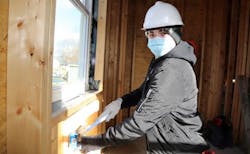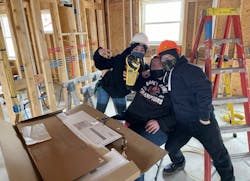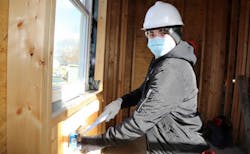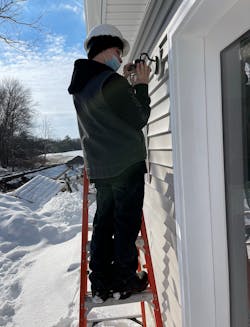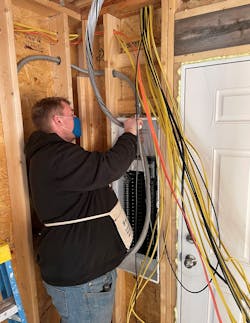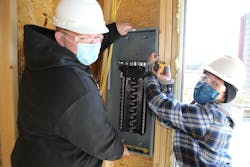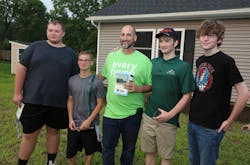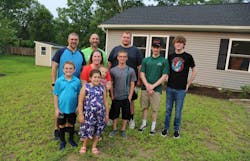Inspiring the Next Generation of Electrical Workers
In the town of Saugerties, N.Y., a small rural town in Ulster County located a little less than an hour south of the state’s capital of Albany, a unique program between the county’s Habitat for Humanity chapter and its trades education program is allowing junior- and senior-aged students studying in the electrical construction and maintenance program at the Ulster Board of Cooperative Educational Services (BOCES) to gain hands-on experience while also serving the community.
Michael Catalano, a master electrician with field experience since 1989 and longtime guidance counselor at Saugerties High School, helped advocate for and oversee this unique partnership after getting involved with the local Habitat chapter as its lead electrician. When the opportunity presented itself to have the kids come on site and use their electrical theory in hands-on, real-life practice, he was thrilled.
Three years and three builds later, Catalano said having a fully supportive school administration has made a world of difference in moving this program forward and steering kids toward the electrical trade. When the program began nearly four years ago, the students could only work on the weekends. But in their third year, they were given the chance to take kids to the job site during the week, which ultimately allowed the work to be counted toward school credit – something that helped encourage more students to participate.
“Whatever the motivation, at least I get them in the building working. Maybe I can steer them in a real good, positive direction,” Catalano said. “I feel like if kids don’t have some hands-on in a real job, many of them may not pursue electrical work at a higher level.”
Real-world experience… and real-world challenges
On the latest Habitat home, which was completed in the fall of 2021, Catalano and his crew of six students (five of whom are from the electrical construction and maintenance program) worked on the house every Wednesday. The students were given the opportunity to do almost everything required electrically on the project — from installing a concrete-encased grounding electrode (Ufer ground) to pulling in service cable from the utility pole to a pad mount step-down transformer. They also installed a secondary underground residential distribution (URD) cable to a 200A meter can, which fed a 200A load center. They even installed the low-voltage Cat. 5 communications cable (computer) and RG 6 cable (television) and connected the low-voltage control equipment.
But that opportunity didn’t come without challenges. For example, when Catalano started on the third house with his crew of students, they didn’t have an electrical schematic. “Guess what? For a lot of jobs, you’re going to walk into a space and there’s going to be no schematic,” Catalano explained to the kids on day one. “You’re going to have to go back to your National Electrical Code — and your training.”
With each new Habitat build, each student got the chance to try different things, including running circuits, figuring out which gauge cable to choose, learning how to perform installations up to Code, and more. However, the third house (a four-bedroom structure for a family with a young girl in a wheelchair) required the students to work with ADA requirements/recommendations and exercise some new skills. For example, with Catalano’s guidance, the students raised the receptacle locations and lowered switch heights while incorporating other ergonomic features to make life easy for the family moving in.
Even factors such as the weather played a big role in the build – living in Eastern New York means harsh winters are a very real challenge. During the coldest days, breaks were spent around heaters in order to keep their hands nimble enough to do work.
“There were a lot of obstacles we had to deal with,” Catalano said in a June 2021 EC&M podcast episode. “But we rolled up our sleeves, and we worked together.”
Positive impact for students
Catalano, other professional workers on the job sites, and school administrators/teachers are not the only ones who understand the positive impact this partnership is having on the next generation of electrical workers – the students also see how much they’ve learned from it.
In a June 2021 EC&M On Air podcast recording, three of Catalano’s electrical students who worked on the third Habitat home had the chance to speak on why they became interested in electrical work in the first place, their experiences working on the job site, and what the future holds for them in the electrical industry. The full podcast can be listened to online.
The students included Jonathan Toth, Kaitlyn Lennon, and Dylan Senor, who graduated in June 2021. All three were students at Saugerties High School and enrolled in the two-year electrical construction and maintenance program at Ulster BOCES. Additionally, all three are strongly considering continuing their education in the electrical industry after graduation.
One of Toth’s favorite skills he learned throughout his time working with Catalano on the job site was working with the panel. “The panel is really fascinating because the panel runs all electric to the whole house,” he said.
Catalano also expressed his pride in Toth’s work, sharing that he wired almost the entire panel himself. “I showed him minimal instruction,” he said. “And then I backed away, and Johnathan just did his own thing. It was inspiring to see a young man taking off right in front of me.”
For Lennon, working on the job site helped give her more confidence in her workmanship, especially when it came to wiring devices. “With BOCES, it helped me learn how to wire the devices,” she added. “But when it comes to the Habitat house, it taught me how to take that knowledge of devices and put it into the real world.”
Meanwhile, Senor got to participate in one way he’ll never forget – being in the ceiling and running wires all over the house. “It was a really tight space in some spots. And just having to stand in it, going from beam to beam is interesting,” he shared in the podcast. “It’s a once-in-a-lifetime experience.”
A possible solution to an industry-wide issue
The unique partnership between Ulster BOCES and Habitat for Humanity not only gives students the chance to gain real-life, hands-on electrical skills and aid their community, but it also presents a potential solution to one of the industry’s biggest hurdles: worker shortages.
It’s certainly not news that the electrical industry has faced a shortage of skilled workers for many years. According to the 2021 EC&M Top 50 Electrical Contractors special report, 75% of Top 50 firms are experiencing worker shortages, and a whopping 83% plan to add employees. Coupled with more than 40 of the 50 firms responding that difficulty finding and retaining quality employees is the No. 1 factor having the most negative impact on their business growth, it’s clear that the electrical industry may need to shift recruitment, training, and retainment strategies.
Programs like the partnership between Ulster BOCES and Habitat show how positive experiences such as this can help encourage the next generation to pursue a career in the electrical field. However, cooperation from everyone – from school leadership all the way down to students – is key for programs such as Catalano’s to find success.
At first, students worked on the first two houses (which took about a year each to complete) almost solely during the weekends. However, Catalano continued to push to have students be able to work during school days to make the hands-on opportunities more accessible and allow them to gain school credit in the process. Fortunately, he was met with a supportive administration. “Your leadership must be supportive to think out of the box and take some calculated risks,” Catalano said. “That’s how you get movement.”
Leadership has continued to be nothing but supportive, allowing Catalano to really take the reins and lead this program toward the future. “They got us the movement and traction we needed,” he added.
And school administration is nothing but proud of the students’ work. “The partnership between the Saugerties CSD and the Habitat for Humanity was an amazing opportunity for our students,” said Kirk Reinhardt, superintendent of Saugerties Central School. “The experiences, hands-on lessons, and soft skills learned by our students will benefit them throughout their future careers and training. To have this once in a lifetime experience during this challenging time of a pandemic is wonderful. We cannot be more proud of our students and staff.”
“I am so proud and humbled by the commitment of our students,” added Saugerties High School Principal Tim Reid. “In spite of a pandemic, these students continue to serve their community. They exemplify the best of qualities in all of us.”
What’s next?
The whole community is thrilled that this partnership isn’t ending with house No. 3 – in fact, the fourth, fifth, and sixth Habitat builds are currently underway. And now, all Ulster BOCES electrical construction and maintenance students – around 50 in total – and their teachers will get the chance to work on these homes, two of which are currently underway in the same development as the first three.
Additionally, Esopus, N.Y.-based The Mount Academy (a four-year private high school founded by the Bruderhof, a Christian community movement) and the Mennonite Disaster Service (MDS) is also partnering on the modular build that is being completed on its 500-acre campus. MDS donated $50,000 so far to support the modular build, which is expected to be delivered to the Habitat development in May or June. Recently, students from both The Mount and BOCES worked together to perform its rough wiring.
“We’re all together in this,” Catalano said, adding that he and the Mount’s technology teacher, their main electrician, coached the students. The initial electric work was ultimately completed over the course of a few days.
Students from the Mount are also welcomed to work on the homes located in the Habitat for Humanity development. Students from both the Mount and BOCES recently helped Catalano install a stanchion, 200A meter, and more to run temporary power to the job sites. Today, all three of the new homes are roughed-in, and one is energized. The others will be powered up by August 2022.
If everything goes as planned, all three homes will be completed by the end of the summer or early fall, helping give three more deserving families a place to call their own.
More than just electrical work
While teaching the students the necessary skills to be successful in the electrical trade is part of what brings Catalano pride and joy, he truly believes it goes beyond mere electrical skills. “It’s even bigger than just wiring a building,” Catalano emphasized. “It’s really sending the message of the importance of giving back and helping people. I’m hoping that the kids will grab on to that.”
It certainly seems this is the case. Several of Catalano’s students had the chance to witness the family finally receive the keys to their home in July 2021. It was a packed house of nearly 100 people there to celebrate, Catalano estimated.
“It was great to hand the keys over to them, knowing that they’re all going to be safe now,” Toth said.
Characterizing the experience as “a big accomplishment,” Senor definitely realized the impact of this experience extended far beyond the classroom. “There’s a bunch of people out in the world that literally just don’t have homes, and we’re giving people hopes and dreams,” he said. “It’s how life is these days – you’ve got to be willing to help people to get a little back.”
About the Author
Ellie Coggins Angus
Ellie Coggins Angus is the managing editor for EC&M and was formerly the associate editor for Electrical Wholesaling. She has more than five years of experience in the B2B publishing space covering the electrical contracting/wholesaling industry. Ellie received an MA in journalism from Syracuse University and a BA in English from University of Cincinnati. She is currently based in Cincinnati, Ohio. Connect with her at [email protected] or on LinkedIn.
